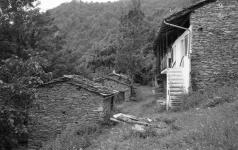|
Aka Akarelle I |
Manufactured or assembled in Germany from 1955 to (Circa) 1957.
Index of rarity in France: Infrequent (among non-specialized garage sales)
Inventory number: 11828
See the complete technical specifications
Chronology of cameras Aka
Although it had a short existence, Aka manufactured a considerable number of camera models, all sharing a high level of craftsmanship. The first series was called Akarette, which was soon followed by Akarelle. A few years later, a redesign of the cameras led to the appearance of the Arette series.
Akarette cameras are small cameras with interchangeable lenses. Their top cover has a characteristic bulge, as the viewfinder is double, corresponding to two different focal lengths. The camera's length is indicated under the front panel's two windows. A button or lever allows the photographer to move an obstacle in one of the viewfinder parts, so they can remember the focal length in use. Of course, the photographer needs to move this point manually when changing lenses.
The Akarelle is an evolution of the l'Akarette. The most obvious difference is the replacement of the film advance button with a lever, but the features remain largely the same. The shutter (integrated into the housing) is a Prontor SVS. The two viewfinders are now for 50mm and 90mm lenses. The range of lenses also included 35mm and 75mm.
During its existence, the Akarelle undergoes changes, and starting from 1955, the small lever that displayed an obstruction in the viewfinder to indicate incompatibility with the lens mounted on the camera is removed. Subsequently, only bright frames are present in the viewfinder to determine the framing for different existing focal lengths. Aside from these frames, the viewfinder corresponds to the 35mm focal length.


The history of the Aka brand (an acronym for Apparate & Kamerabau) is closely linked to World War II and its aftermath. The brand was founded in 1946 by the Armbuster brothers in the French sector. One of the brothers had skills in camera production, having worked for major German manufacturers of cameras and shutters. The other had a foundry and a tool factory.
Production of a central shutter camera with interchangeable lenses began in an old hotel in Wildbad. This camera was called the Akarette and aimed to be a more affordable competitor to the Leica. The first models produced negatives of 24 x 32 mm, which allowed for more shots per film. However, this was quickly abandoned in favor of the 24 x 36 mm standard. Production gradually increased with the German economy's recovery, requiring larger premises. Unable to find any in Wildbad, the company moved to the shores of Lake Constance, to Friedrichshafen, in the former pilot school. Production started there in April 1949. The range diversified with simpler models than the first Akarette, or more elaborate models with rangefinders.
In 1958, one of the brothers left the company for Feinwerktechnik, while developing a stereo camera compatible with View-Master, whose financing was a source of dispute between the brothers. This departure marked the beginning of the company's decline. Bankruptcy followed in 1960. A new company, Arette Feinwerktechnik GmbH, built cameras until 1963, using the parts still in stock.
Aka cameras are sometimes found at French flea markets. Sellers who know the history of their camera often mention its purchase by a conscript who served in Germany, either in the Black Forest or around Lindau, in the 1950s.
1 As a reminder, the French, American, British, and Soviet sectors were the result of the Yalta agreements that defined a partition of Nazi Germany between the victorious powers. Each occupying force exercised full administration over its sector. In 1949, the creation of the two German states significantly reduced the prerogatives of the four occupying nations. Military presence was maintained until after reunification in 1993.
2 Friedrichshafen is the city of Zeppelin and Dornier airplanes.
(original document in german)
Interesting links or bibliography :
Add a link or element of bibliography, a picture taken with this camera, a picture of box or an ads about this camera
Your photos taken with the same camera:
Cameras from Ebay France (Aka) (Uploaded each 3 hours)








